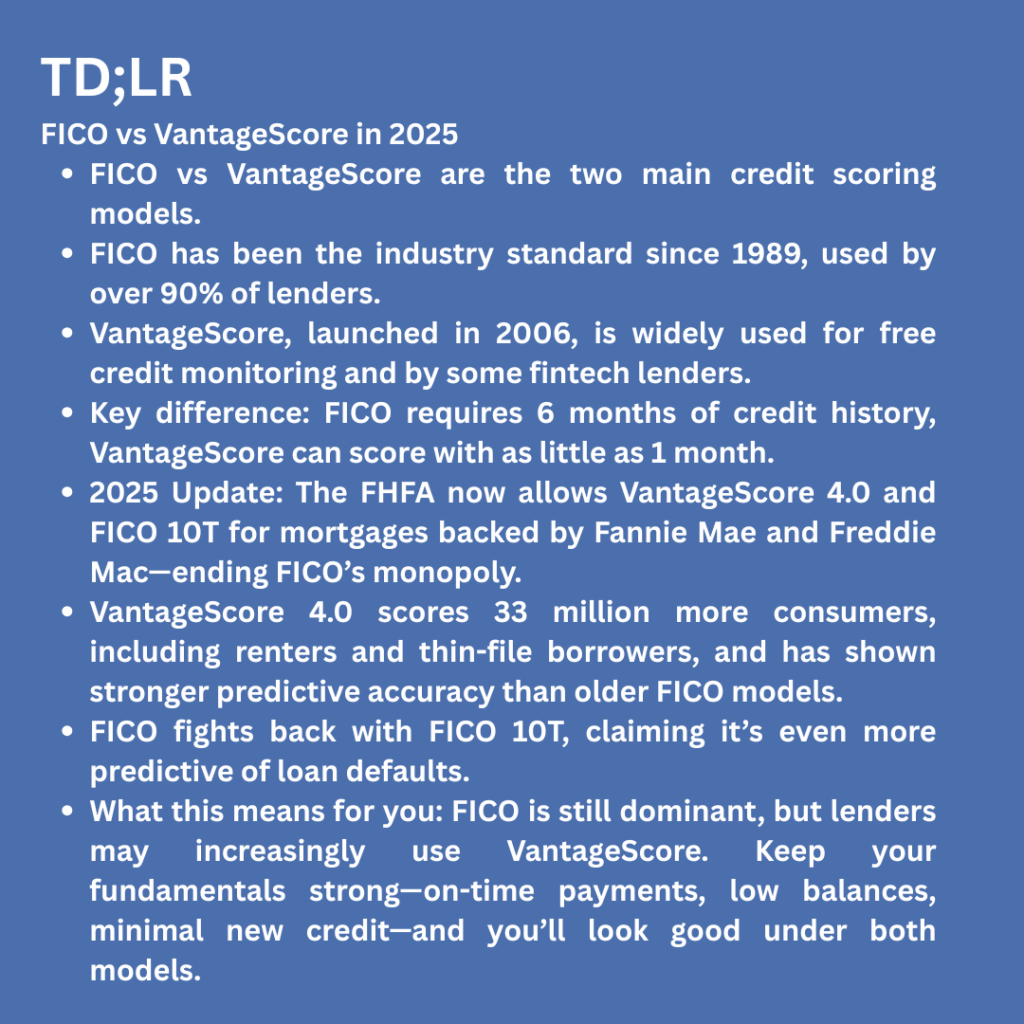Understanding the FICO vs VantageScore Debate
When consumers check their credit, they often run into a common source of confusion: FICO vs VantageScore. These are the two most widely used credit scoring models in the United States, and while both generate a three-digit score based on your credit history, they aren’t identical. Because of this, you might notice your score varies depending on where you check it. That raises a big question for anyone planning to buy a home, finance a car, or apply for a business loan: which score does your lender actually rely on?
The Origins of FICO vs VantageScore
FICO scores were introduced in 1989 by the Fair Isaac Corporation and have since become the industry standard for most lending decisions. In fact, more than 90% of top lenders use some version of the FICO model when reviewing applications.
VantageScore, on the other hand, was created in 2006 by the three major credit bureaus—Equifax, Experian, and TransUnion—as an alternative. While newer, VantageScore has gained traction among online lenders, credit monitoring platforms, and even some traditional banks. Its goal was to provide more consistency across bureaus and offer scoring for consumers with thin credit files.
FICO vs VantageScore: Key Differences in Scoring
Both models look at similar factors—payment history, credit utilization, length of credit history, new credit, and credit mix. However, the weight they assign to each can differ.
For example, FICO places the most significant emphasis on payment history (around 35%). At the same time, VantageScore has historically been more sensitive to recent credit behavior, such as how often you apply for new accounts. Another difference: VantageScore can usually generate a score for people with as little as one month of credit history, while FICO generally requires at least six months of activity.
These differences can mean your FICO vs VantageScore results don’t perfectly match, even if they’re based on the same credit report.
Which Score Do Lenders Use?
Here’s the straightforward answer: when it comes to FICO vs VantageScore, the majority of lenders use FICO. Mortgage lenders in particular are required by federal housing agencies like Fannie Mae and Freddie Mac to use specific versions of FICO scores. Auto lenders and credit card issuers also lean heavily on FICO.
That doesn’t mean VantageScore is irrelevant. Many personal loan companies and fintech lenders use it as part of their underwriting. Plus, when you check your score through free monitoring apps, there’s a good chance you’re looking at a VantageScore. It provides a valuable snapshot of your credit health, but you should remember that your actual lender may be viewing your FICO score instead.
The Latest Information: 2025
 As of 2025, the FICO vs VantageScore landscape is changing dramatically—especially in the mortgage market.
As of 2025, the FICO vs VantageScore landscape is changing dramatically—especially in the mortgage market.
New FHFA Guidance Shakes Up Mortgage Lending
In July 2025, the Federal Housing Finance Agency (FHFA) approved the use of VantageScore 4.0 alongside FICO 10T for mortgage underwriting through Fannie Mae and Freddie Mac—two entities that account for nearly half of U.S. mortgage originations (WSJ). This is a historic shift: for decades, only FICO was accepted. While lenders are not required to switch immediately, the move signals growing recognition of VantageScore as a reliable alternative.
VantageScore’s Expanded Reach and Predictive Power
Recent studies show VantageScore 4.0 can predict mortgage defaults with greater accuracy than older FICO models. It identified up to 13% more defaults, delivered a 3.8% predictive lift, and scored 33 million additional consumers, including 5 million who may now qualify for mortgages thanks to the inclusion of rent, utility, and telecom data (VantageScore Press Release).
This is especially important for first-time buyers, gig workers, and consumers with limited credit histories who have often been excluded under traditional scoring models.
FICO’s Counterpunch with Version 10T
Not to be outdone, FICO has introduced FICO 10T, which it claims is more predictive of loan risk than VantageScore 4.0. Some independent studies suggest FICO 10T is five times more accurate than the older Classic FICO models still widely used in mortgage lending (Mortgage Underwriters News).
Still, the adoption of new models will take time. Many lenders remain cautious, and transitions are expected to roll out gradually over several years.
Market Impact and Consumer Takeaways
The FHFA decision triggered a sharp market response: Fair Isaac Corp. stock dropped nearly 9% immediately after the announcement, with later reports showing losses of up to 15% (Barron’s). This shows just how disruptive VantageScore’s inclusion is to FICO’s dominance.
For consumers, the practical takeaway is simple: lenders now have more scoring tools, and your rent, utility, and telecom payments may count in ways they didn’t before. That can mean broader access to credit and more equitable lending outcomes.
Why FICO vs VantageScore Matters to Consumers
If you’re preparing to apply for a loan, it’s wise to understand the FICO vs VantageScore distinction. A strong VantageScore doesn’t always guarantee that your FICO score will look the same—and that can affect your approval odds or the interest rate you’re offered.
This is especially important because lenders often use industry-specific FICO models. For instance, auto lenders may pull an “Auto FICO” version that weighs car loan history more heavily. Mortgage lenders typically use older FICO versions still required by regulators. Meanwhile, your bank app might be showing you a VantageScore that looks slightly higher.
How to Prepare Regardless of FICO vs VantageScore
 Instead of stressing over the differences, focus on the shared fundamentals that both models reward:
Instead of stressing over the differences, focus on the shared fundamentals that both models reward:
- Pay all bills on time, every time.
- Keep credit card balances well below 30% of your limits (ideally under 10%).
- Avoid opening too many new accounts at once.
- Regularly check your credit reports for errors and dispute inaccuracies.
By following these steps, your score will rise across both models. That means whether your lender uses FICO vs VantageScore, you’ll be in a stronger position.
The Bottom Line on FICO vs VantageScore
Both models serve as valuable tools for measuring credit health. But when it comes to actual lending decisions, FICO has historically been the dominant player. Now, with 2025 FHFA changes, VantageScore is positioned to play a larger role in mortgage lending and beyond.
So if you’re asking, “Which score will my lender use?”, the safest assumption remains FICO—at least for now. But as adoption of newer models grows, the gap between FICO vs VantageScore will narrow, giving consumers more opportunities than ever to benefit from responsible credit behavior.

